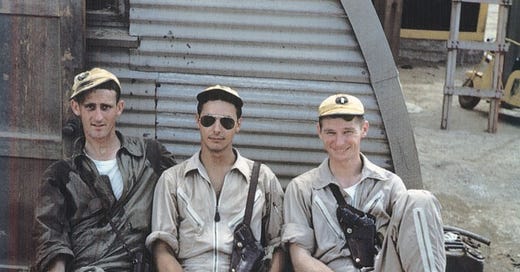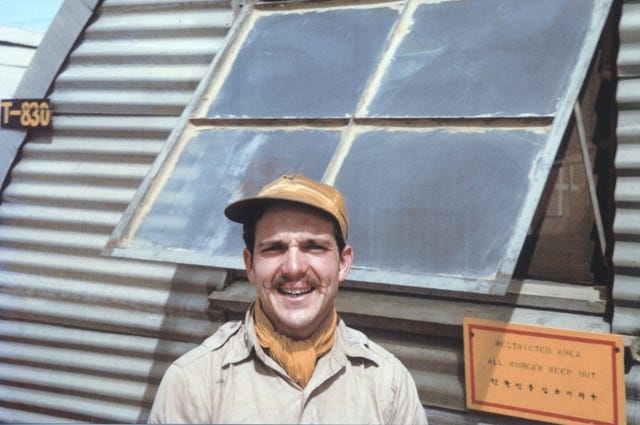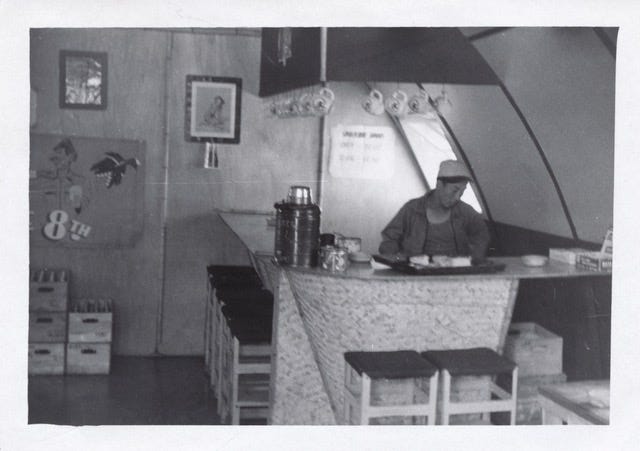Some of them became life-long friends with histories all their own: No two alike. And all thrown together in an environment most had never experienced before in their life. Some of Chet’s thoughts: We re-treads who arrived in [Korea] late 1951, early 1952 were truly a mixed bag. About the only common thread may have been a common love of flying and a strong desire to keep flying Air Force aircraft. Most of us had a year or two of college before we enlisted in pilot training as Aviation Cadets. In 1944, when I graduated, I was nineteen. Most Pilot 2nd Lieutenants were nineteen or twenty; 1st Lieutenants - twenty-one; Captains - twenty-two/twenty-three; Majors - twenty-three; Lieutenant Colonels - twenty-three/twenty-four; and Colonels - twenty-four/twenty-five. Some of the Colonels I knew were only twenty-three. We grew up fast in those days.
[Then] one day in 1950 I was scheduled to fly an F-84 test hop. Don Blakeslee (Chet’s prior squadron commander) received a call to go to the wing briefing room immediately. He returned to the Squadron in about thirty minutes and called for all the pilots to follow him into the squadron briefing room. As soon as the door closed behind the last pilot, Don made the following announcement: “There has just been a piddling little war started in some place called Korea, a place I had never heard of until today. It’s not much of a war, but it is better than no war at all. That is all we know at this time, except we have been placed on an alert status. Get ready for anything.”
_________________________
Arriving three months before Chico, his first day was one he’d never forget. Before receiving orders, Chet’s best friend, Jim Peuter, arrived at K-2. In the interim, they corresponded while Chet waited for his orders. The goal: Chet was to suave his way to Jim once in Japan. When Chet arrived at Fuchu, he wrangled orders for K-2, hoping to fly combat with Jim. So, the day Chet arrived, Jim was taking off on his fifth mission holding number-two position. The two of them did not get to say hello, although Chet saluted while Jim took off. Sadly, it was the last time Chet saw his friend. He was then assigned his first F-84, Anne’s Bad Penny! Anne, his wife, the penny, himself. The bad one that always returns. Five weeks in, Chet flew his fifth mission in the same position on the same type sortie when Jim was KIA (killed in action).
So, when Chico arrived at K-2, the two became friends. They were in the same squadron, although different flights. Occasionally they flew the same mission in a gaggle. And once Chico was assigned a flight, his Lead was John Taylor. He weighed roughly 145 pounds wet and stood five feet eight. But when suited, he tipped the scales weighing just over two hundred pounds. He had piercing steel-blue eyes, matched with nerves of rock-hard fighter-pilot. He sported a mustache, handlebar style, and was ready to fight in the air or on the ground.
In Korea every pilot put together his own escape and evasion kit in case they bailed. In combat, once the coziness of the cockpit was lost, it was an escape situation to survive. Most pilots carried a .45 caliber pistol with extra rounds, including food reserves. Some also carried a monetary exchange like gold to barter or buy a way back south. Not John: He went to fight! Starting with one .30 caliber carbine with retractable stock, John also carried two .45 pistols. Making certain he had enough ammunition, he wore two bandoliers, one on his right shoulder, the other on his left down to his waist, loaded with .30 caliber rounds. The .45s had their share of extra ammunition. John wore a western style belt, but instead of one row, it was custom made with two rows of loops in complete circumference of his waist.
Pilots also wore backpacks and seat packs along with parachutes. In his seat pack, John had .45s with .30 caliber in the backpack. Before sorties, he always told his flight: “If I go down, don’t bother flying CAP (combat air patrol), I’ll get back.” There was one problem though. If John bailed, he would have never wanted to over open water.
Before flying combat, pilots sat through a presentation from an experienced veteran. It covered everything down to the escape and evasion kit. During one presentation, Chet, the presenter, went through the drill, showing his kit. By coincidence, John had just returned from a mission, making his way through operations. Chet grabbed him and asked if he would present his kit. As John laid a pile of weaponry on the table, the newbies watched wide-eyed. Amazed, one of them inquired what he’d eat if he bailed. John, with his piercing stare, replied he “would kill what he needed.”
Pairing Chico with John was a good mix of like personalities. Since Chico already had a couple years flying under his belt, he was thrown right into combat instead of training hops to get comfortable. On the first few missions, his squadron commander, Bill Georgi, flew Lead to Chico, acclimating him to the environment of combat. Georgi is not around anymore, but first impressions are everything. Per Chet: Chico was pretty cocky when he first got there. I’d say, “Who is this guy anyway?” But I soon found out he was just about as good as he thought he was.
K-2 was spartan with single-story barracks housing twenty pilots each, including separate showers. Toilets though, communal “one holers” where everyone sat side by side, conversed, and did their dudes. Some unlucky soul washed out the holding trough when full. The mess hall was common for all officers. Korean girls worked it, so they ate well. And each squadron had a “hooch” on the flight line with a bar manned by Korean barkeeps. Pilots hung with their squadron when relaxing. Nothing fancy but stocked with beer.
Free time around the squadron was spent reading, talking, playing cards, studying, or working various projects. Movies were outdoors. When things chilled, they received a bubble building (blow up) to use for movie watching, weightlifting, and whatever else they could fit inside. The base was located near Taegu, affording sightseeing and enjoying local traditions when off duty. The town did have an Army Officers Club where one could go for a change of pace, get a meal, and interact with ground pounders.






Good reading as usual. I liked the pictures. Keep on writing.